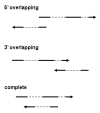antiCODE: a natural sense-antisense transcripts database
- PMID: 17760969
- PMCID: PMC1997216
- DOI: 10.1186/1471-2105-8-319
antiCODE: a natural sense-antisense transcripts database
Abstract
Background: Natural antisense transcripts (NATs) are endogenous RNA molecules that exhibit partial or complete complementarity to other RNAs, and that may contribute to the regulation of molecular functions at various levels. In recent years, large-scale NAT screens in several model organisms have produced much data, but there is no database to assemble all these data. AntiCODE intends to function as an integrated NAT database for this purpose.
Results: This release of antiCODE contains more than 30,000 non-redundant natural sense-antisense transcript pairs from 12 eukaryotic model organisms. In order to provide an integrated NAT research platform, efficient browser, search and Blast functions have been included to enable users to easily access information through parameters such as species, accession number, overlapping patterns, coding potential etc. In addition to the collected information, antiCODE also introduces a simple classification system to facilitate the study of natural antisense transcripts.
Conclusion: Though a few similar databases also dealing with NATs have appeared lately, antiCODE is the most comprehensive among these, comprising almost all currently detected NAT pairs.
Figures


Similar articles
-
Small RNAs and the regulation of cis-natural antisense transcripts in Arabidopsis.BMC Mol Biol. 2008 Jan 14;9:6. doi: 10.1186/1471-2199-9-6. BMC Mol Biol. 2008. PMID: 18194570 Free PMC article.
-
Pseudogenes as an alternative source of natural antisense transcripts.BMC Evol Biol. 2010 Nov 3;10:338. doi: 10.1186/1471-2148-10-338. BMC Evol Biol. 2010. PMID: 21047404 Free PMC article.
-
Prediction of trans-antisense transcripts in Arabidopsis thaliana.Genome Biol. 2006;7(10):R92. doi: 10.1186/gb-2006-7-10-r92. Epub 2006 Oct 13. Genome Biol. 2006. PMID: 17040561 Free PMC article.
-
Natural antisense transcripts in plants: a review and identification in soybean infected with Phakopsora pachyrhizi SuperSAGE library.ScientificWorldJournal. 2013 Jun 26;2013:219798. doi: 10.1155/2013/219798. Print 2013. ScientificWorldJournal. 2013. PMID: 23878522 Free PMC article. Review.
-
[Natural antisense transcript and its mechanism of gene regulation].Yi Chuan. 2010 Feb;32(2):122-8. doi: 10.3724/sp.j.1005.2010.00122. Yi Chuan. 2010. PMID: 20176555 Review. Chinese.
Cited by
-
The Evolution and Expression Pattern of Human Overlapping lncRNA and Protein-coding Gene Pairs.Sci Rep. 2017 Mar 27;7:42775. doi: 10.1038/srep42775. Sci Rep. 2017. PMID: 28344339 Free PMC article.
-
Transcriptional regulation of translocator protein (Tspo) via a SINE B2-mediated natural antisense transcript in MA-10 Leydig cells.Biol Reprod. 2012 May 10;86(5):147, 1-15. doi: 10.1095/biolreprod.111.097535. Print 2012 May. Biol Reprod. 2012. PMID: 22378763 Free PMC article.
-
RNAi screen indicates widespread biological function for human natural antisense transcripts.PLoS One. 2010 Oct 4;5(10):e13177. doi: 10.1371/journal.pone.0013177. PLoS One. 2010. PMID: 20957177 Free PMC article.
-
Identification of differentially expressed sense and antisense transcript pairs in breast epithelial tissues.BMC Genomics. 2009 Jul 17;10:324. doi: 10.1186/1471-2164-10-324. BMC Genomics. 2009. PMID: 19615061 Free PMC article.
-
OverGeneDB: a database of 5' end protein coding overlapping genes in human and mouse genomes.Nucleic Acids Res. 2018 Jan 4;46(D1):D186-D193. doi: 10.1093/nar/gkx948. Nucleic Acids Res. 2018. PMID: 29069459 Free PMC article.
References
-
- Engstrom PG, Suzuki H, Ninomiya N, Akalin A, Sessa L, Lavorgna G, Brozzi A, Luzi L, Tan SL, Yang L, Kunarso G, Ng EL, Batalov S, Wahlestedt C, Kai C, Kawai J, Carninci P, Hayashizaki Y, Wells C, Bajic VB, Orlando V, Reid JF, Lenhard B, Lipovich L. Complex Loci in human and mouse genomes. PLoS Genet. 2006;2:e47. doi: 10.1371/journal.pgen.0020047. - DOI - PMC - PubMed
-
- Yelin R, Dahary D, Sorek R, Levanon EY, Goldstein O, Shoshan A, Diber A, Biton S, Tamir Y, Khosravi R, Nemzer S, Pinner E, Walach S, Bernstein J, Savitsky K, Rotman G. Widespread occurrence of antisense transcription in the human genome. Nat Biotechnol. 2003;21:379–386. doi: 10.1038/nbt808. - DOI - PubMed
Publication types
MeSH terms
Substances
LinkOut - more resources
Full Text Sources
Other Literature Sources
Research Materials

